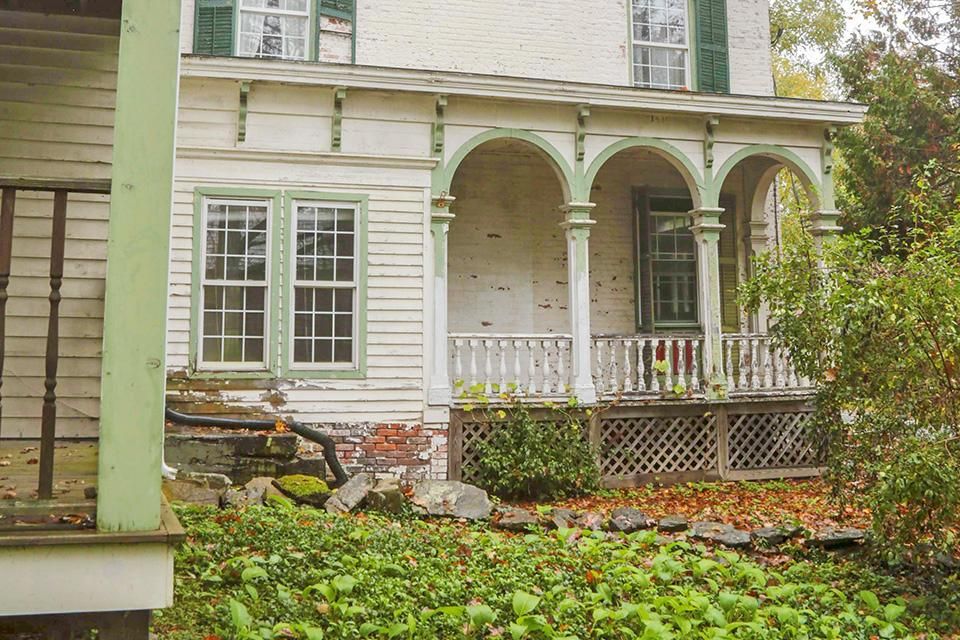Susan B. Anthony’s Childhood Home Is Getting Renovated
The women’s suffrage activist lived in the house from 1833 to 1839
:focal(452x278:453x279)/https://tf-cmsv2-smithsonianmag-media.s3.amazonaws.com/filer/40/ab/40ab3a45-caf2-44d8-89fe-c36441829947/slide1.jpg)
Susan B. Anthony’s childhood home is fairly nondescript, with just a small placard in the stone retaining wall and a sign suspended from a post by the road advertising its connection to the famed suffragist. Here, in Battenville, New York, the young Anthony had a slew of formative experiences—from facing discrimination on the basis of sex to witnessing slavery—that informed her later activism.
After years of vacancy, water damage and mold growth, the brick house, where Anthony lived from ages 6 to 19, is slated for renovation. As Wendy Liberatore reports for the Times-Union, the New York Office of Parks, Recreation and Historic Preservation recently announced plans to commit $700,000 toward repairs.
“There is fungus growing out of the floors and walls,” former president of the Washington County Historical Society Debi Craig tells the Times-Union. “There is an issue of black mold. There is a major problem with moisture in the house.”
Craig says she has known of the house’s significance since her own childhood, when her father would point it out every time they drove past.
She recalls him saying, “Don’t forget Susan B. Anthony lived there. She’s part of the reason you can vote.”
/https://tf-cmsv2-smithsonianmag-media.s3.amazonaws.com/filer/03/eb/03eb6f4d-e8bb-4c65-bcef-ba46b1986523/susan_b_anthony_-_age_28_-_project_gutenberg_etext_15220.jpg)
Anthony’s father, Daniel, moved his family from Massachusetts to New York in 1826, when he was offered a job managing a local cotton mill. In 1832, Daniel started building the family home, conveniently overlooking the mill, with bricks cast onsite. The house had enough room for Daniel, his wife, their six children and his in-laws. After Anthony’s teacher refused to teach her long division and told her to learn needlepoint instead, Daniel added a homeschooling room where his children could receive a more diverse education.
Even before her father’s intervention, Anthony found ways to skirt her teacher’s limitations.
“Susan told her teacher she was cold, stood by the stove and listened to the lesson,” says Craig to the Times-Union. “She learned long division.”
While living in the Battenville house, Anthony met two enslaved individuals at a local family’s home. As a young adult, she served as a teacher and was paid $1.50 weekly—a far lower wage than her male predecessor’s $10 per week. Then, while spending a few weeks working in her father’s cotton mill as a spooler, she learned that the women’s wages were paid directly to their husbands or fathers.
“So many things happened here,” Craig tells the Post-Star’s Kathleen Phalen-Tomaselli. “She formed her opinions here.”
The financial collapse wrought by the Panic of 1837 hit the Anthonys hard. By 1839, they had been forced to sell their house, as well as personal and household items including sugar, eyeglasses, and undergarments. The family moved a few miles down the road to a former inn, where they remained until relocating to Rochester, New York, in 1845. Anthony would live in the Rochester house, where she was arrested on the front porch in 1872 for voting in a presidential election, until she died in 1906.
The Rochester house is now a popular historic landmark, but Anthony’s childhood home, which passed through various owners and periods of disuse after the family moved out, is little-known. In the 1990s, the schoolroom was replaced with an apartment, and in 2006, the house went into foreclosure. That same year, the New York Office of Parks, Recreation and Historic Preservation acquired the property for $1.

Since then, the house has remained unused. In 2018, however, the property was recognized by the Cultural Landscape Foundation in its Grounds for Democracy report.
“The people and events that helped shape our democracy are often strongly associated with cultural landscapes,” Charles Birnbaum, president and CEO of the Cultural Landscape Foundation, tells the Post-Star. “As we near the centennial of women’s suffrage, it’s important that a place that bore witness to one of the movement’s most consequential leaders endures.”
The $700,000 investment is a first step toward making Anthony’s childhood home a visitor-friendly landmark, but the property’s exact future remains in flux. Because the house is situated close to a busy road, its driveway is steep and unpaved. The parcel of land also lacks space for a parking lot, meaning it may not have a future as a museum.
But Craig tells the Times-Union that the building could have a future as a research center or library dedicated to women’s rights. She also hopes to create a historical Susan B. Anthony trail that would trace a path from Adams, Massachusetts, to Battenville, Seneca Falls and Rochester.
“You could make an entire week’s vacation in New York state with stops in towns like Greenwich, which have a great history,” Craig tells the Times-Union. “That’s what I’d like to see, even if the house doesn’t become a museum.”